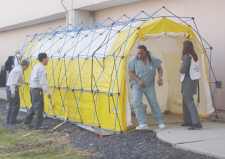It was only 9 a.m., but already on Wednesday morning, six patients had come to the Meadowlands Hospital describing symptoms of the pneumonic plague. They were actors – just volunteers in a terrorism drill that was part of the state’s weeklong “Top Off 3” terrorist attack simulation. “Top Off” stands for the top officials who participated. On Wednesday, the actors, who were supplied by the state, appeared at the Meadowlands Parkway facility periodically throughout a designated four-hour period. Hospital public information officer Linda Ziegler said the drill prepared the hospital for possible real-life events. “There was a big learning curve after 9/11,” said hospital administrator Martin Baicker. “You need to get your people ready to be able to respond to a terror attack.” The mock scenario showed hospital staff the weakness and strengths of their response to an epidemic. Treatment of the plague, as well as infection control, was issues addressed by the drill.
Preparing for the worst
Hospital staff evaluated each patient, who had a two-page script of clinical information provided by state authorities.
Emergency admissions staff responded to symptoms listed on the front page. An hour later, doctors and nurses responded to test results listed on the second page.
While the symptoms themselves may not be out of the ordinary of many illnesses, Backer says what’s being tested is how the staff deals with “surge capacity” and determining the actual presence of the plague.
A large number of patients with a pattern of similar conditions can tax the limits of the facility. Staff members were required to locate beds and other necessities.
Twelve “patients” were treated by the end of the day. Only seven patients were admitted with the pneumonic plague. The rest were released. Their symptoms were determined to be from lesser problems, such as the flu.
Lessons learned
The mock attack revealed some problems with building access during a lockdown situation, internal communication issues, and a need for an updated internal emergency plan due to function change of a number of areas within the hospital, according to Baicker.
“We learned important lessons from this very helpful exercise,” said Baicker. “It was a great success.” The plague scenario provided a domino effect, as the drill spread from one facility to another within the state. State authorities tested reporting techniques, computer network links, and other communication conduits between hospitals and other health care providers.
The hospital could possibly be on its own for the first 24 to 48 hours if the attack was regional or otherwise widespread.
Since the pneumonic plague is treated with antibiotics, Baicker says state authorities discussed “prophylacticizing the population” by dispensing antibiotics at local post offices.
Taking the medication would prevent residents from contracting the disease if the state were under attack by airborne weapons of mass destruction.
“That would create a new set of problems for local authorities because of panic and traffic control,” said Baicker.
